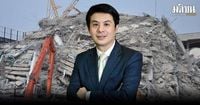In a shocking incident that has raised concerns about building safety and engineering practices in Thailand, a new report has emerged regarding the collapse of a construction site for the Office of the Auditor General on March 28, 2025. The building, which was under construction, collapsed entirely, prompting an urgent investigation into the causes of the disaster.
Dr. Amor Phimanmas, the president of the Structural Engineers Association of Thailand and a professor at Kasetsart University, has been vocal about the need for a thorough analysis of the incident. He stated that video footage from various angles captured the moment of the collapse, revealing that the initial failure occurred at the elevator shaft located at the rear of the building. This failure triggered a catastrophic chain reaction that caused the upper columns to explode, followed by the collapse of the lower columns, ultimately leading to the entire structure falling vertically due to its own immense weight.
The elevator shaft, which is typically a critical structural component designed to support the building's weight, surprisingly became the point of failure. Dr. Phimanmas noted that this was unexpected, given that the walls of the elevator shaft were constructed from reinforced concrete, a material typically known for its strength. He explained that several factors might have contributed to this failure.
Firstly, the positioning of the elevator shaft at the rear of the building may have created asymmetrical conditions that led to twisting and eventual collapse. Secondly, there were reported changes in the construction plans, including a reduction in the thickness of the elevator shaft walls from 30 centimeters to 25 centimeters in certain areas, as noted by the Office of the Auditor General in their report to the House of Representatives’ Budget Committee.
Additionally, questions have been raised regarding the material strength of the concrete used in construction. Samples have been taken for testing, but results on the concrete's compressive strength are still pending. The testing of reinforcing steel has begun, but the outcomes remain uncertain.
Other potential contributing factors include foundation settling, the impact of cranes positioned near the elevator shaft, and whether the seismic forces exceeded the design standards. With these various elements at play, it remains unclear whether the collapse was primarily due to design flaws, construction errors, or external factors.
Dr. Phimanmas emphasized that determining the precise cause of the collapse requires the development of two structural models. The first model would be based on the original design drawings, incorporating the specified material properties and reinforcement as intended in the design. The second model would reflect the actual construction, using the materials and dimensions that were implemented on-site. By analyzing both models under simulated seismic conditions, engineers can ascertain whether the design or construction phase was at fault.
He further explained that the analysis of these models would yield scientifically reliable data, as opposed to mere speculation. This method allows for a numerical explanation of the building's behavior during the collapse, providing clarity on the discrepancies between the design and actual construction.
It is crucial that this analysis is conducted by experts in structural engineering and seismic activity to ensure accuracy. Until the detailed evaluations are completed, it is premature to draw any conclusions regarding the cause of the collapse.
As the investigation continues, the implications of this incident could have far-reaching effects on building regulations and safety standards in Thailand. With the increasing frequency of earthquakes in the region, the need for robust and resilient construction practices has never been more critical.
Meanwhile, in a separate but equally intriguing development, a new AI model from OpenAI has emerged that can identify locations from images, sparking a viral trend on social media. This model, known as ChatGPT, has gained popularity for its ability to analyze uploaded photos and provide precise location information, including identifying landmarks, restaurants, and more.
Since the launch of the new ChatGPT models, o3 and o4-mini, users have been amazed by the AI's capabilities. According to a report from TechCrunch, the AI's ability to interpret images goes beyond basic processing. It can perform advanced image manipulation, such as cropping, rotating, and zooming, even on blurry or distorted images.
This newfound ability has led to a surge in users testing the model with various types of images, from food menus to selfies, to see if the AI can accurately identify where the photos were taken. However, this trend has also raised significant privacy concerns. The ease of using this tool has led to fears that individuals might unintentionally expose their location through shared images, such as those from social media platforms.
TechCrunch's testing of both o3 and GPT-4o revealed that while GPT-4o often provided accurate results faster than o3, neither model guarantees 100% accuracy in location identification. Nevertheless, the trend underscores the increasing capabilities of AI in image interpretation and raises questions about the ethical implications of such technology.
As society grapples with these advancements, the intersection of technology and privacy will undoubtedly be a focal point for discussion in the coming years. With the potential for AI to enhance our lives, it also presents challenges that must be addressed to protect individual privacy and security.
In summary, the collapse of the Auditor General's building and the rise of AI models capable of identifying locations from images highlight the importance of rigorous engineering practices and the need for ongoing discussions about privacy in the age of technology.





